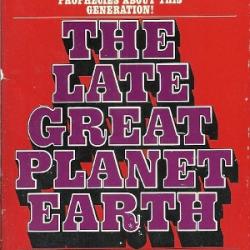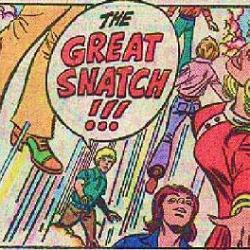Nicolae: The Rise of Antichrist, pp. 19-24
Book 2 of this series managed to be 450 pages long without much actually happening in those pages. Rayford Steele spent most of his time randomly flying from airport to airport, while Buck Williams always seemed to be driving in circles near Chicago.
But now things have changed. The second horseman of the apocalypse has arrived, bringing World War III. Book 3 starts with a bang and the plot is finally lurching forward. Now we’ve got some serious action: Rayford is still flying from airport to airport and Buck is still driving around in suburban Chicago — but Rayford is about to get a much nicer plane and Buck is about to get a much nicer SUV.
The Learjet was a six-seater. Carpathia and Fortunato, deep in conversation, ignored Rayford and Amanda as the couple passed. The Steeles ducked into the last two seats and held hands. Rayford knew global terror was entirely new to Amanda. It was new to him. On this scale, it was new to everyone.
Yes, people had seen global violence before, but not on such a global scale.
Carpathia turned in his seat to face them. He had that fighting-a-grin look Rayford found so maddening in light of the situation.
The Antichrist has irked both of the Steeles ever since they met up with him moments ago when he — conveniently, if inexplicably — turned up right there in suburban Chicago. Amanda is cross with him for pretending not to remember her name. Rayford is irritated that Nicolae seems enthused and excited by the outbreak of war.
It’s “maddening” to Rayford that Nicolae seems pleased by the carnage of war. The Antichrist is raining fiery death down on innocent people and he seems to be happy about it. That’s just evil. Rayford knows that fiery death from the skies is only cause for happiness when it comes from the hand of God, not from the hand of the Antichrist.
This moral logic can get a bit tricky to follow as the series goes on and the body count of the Great Tribulation accelerates. It’s very important for us, the readers, to keep track of the particular source of each ensuing incident of massive, indiscriminate death. Remember: massive, indiscriminate death is, in itself, morally neutral. The morality of such killing can only be determined by discerning who is doing the killing. If it’s the Good Side killing all those people, then such killing is good and righteous and praiseworthy. But if it’s the Bad Side doing the killing, then it’s bad, unrighteous and “maddening.”
If you lose track of which side is ladling out the death, then you might miss out on the happy ending toward which these books are headed. I don’t want to spoil that for you, but as the series develops, we’ll see that the Bad Side just isn’t able to keep up. As powerful as the Antichrist may be, he is no match for an omnipotent God. Thus the Good Side ultimately winds up indiscriminately killing way more people than the Bad Side does. And that of course means that the Good Side wins — something we can all celebrate.
For now, though, it’s understandable that Rayford and Amanda should be annoyed with Nicolae for his barely contained cheer and his odd ribbing of Amanda. What’s bizarre in these pages is that this is the only reason the Steeles are upset with him.
Rayford and Amanda have already completely forgotten this, so it’s easy for the reader to forget about it as well, but they also have a much larger, much more immediate reason to be furious with Nicolae: He just killed Bruce Barnes.
It’s been only two or three hours, at most, since Rayford identified Bruce’s lifeless body in the wreckage of the hospital destroyed by Carpathia’s missile strike. Bruce was supposedly one of Rayford’s closest, dearest friends, his irreplaceable mentor and beloved spiritual guide. But we don’t even need Bruce’s death here to see how inhumanly callous and shallow Rayford is behaving in this chapter.
This is what has just transpired in the past few hours of our story:
1. Rayford walks through the ruins of a hospital — a hospital — and sees dozens of bodies laid out under sheets on the lawn. He sees this, up close, and sees the still-smoldering wreckage of the building in which he knows that dozens, perhaps hundreds, more innocent people are dead or dying.
2. Shortly thereafter, Rayford is face to face with the man who ordered the destruction of that hospital. They shake hands. Then Rayford contemplates why this man failed to greet his wife by name.
Mostly, I think, this is just atrociously thoughtless writing.
Rayford doesn’t give another thought to the carnage at the hospital because Jerry Jenkins is so excited to get to the new plane and the new SUV that he can’t be bothered to write about much of anything else. He just doesn’t think to have Rayford respond to the death of his friend or the horror of the stricken hospital and he can’t be bothered to delay the neat-o plane and Range Rover business with some scene showing Rayford struggling to cope or working his way through denial, anger, bargaining or depression. Rayford is shown, very briefly, to be sad. And then he worries that he may have hurt his knees. And that’s that.
By the time Nicolae Carpathia arrives, Rayford is able to shake hands politely because that’s all done with and we can move along to savor the prospect of the Condor 216.
Yet I also think that Jenkins’ lazy thoughtlessness is reinforced by bad theology and bad politics, and that it can’t be easily separated from them.
Think of that ruined hospital and the row upon row of innocent dead laid out on the grass. To you and to me, a hospital is never, ever an acceptable target. A hospital is a place for the wounded and the sick and they are, by definition, neutral. To target the wounded and the sick and those who treat them is always a war crime — an atrocity.
But Tim LaHaye and Jerry Jenkins don’t see it that way. They can’t see it that way. Their theology won’t allow it. Everything I’ve written above about “indiscriminate” killing or the “innocent” dead is disallowed by their wrathful doctrine that this is the fate that everyone deserves. There is no one innocent, no, not one. A wicked sinner in a hospital bed in the ICU is still a wicked sinner. And so is the nurse by that wicked sinner’s bedside. And they, like all wicked sinners, deserve only death, death and never-ending death at the hands of a righteously angry God.
For LaHaye and Jenkins, then, that makes a hospital as legitimate a target as any other place. They cannot make a distinction because their idea of God makes no such distinction. This is what their God does in their story. God kills indiscriminately because no one is innocent. God directs divine judgment at the wounded and the sick and those who care for them because they are no different from any other rebellious, left-behind sinner deserving to suffer great tribulation in the Great Tribulation.
Nicolae suggests that Rayford go sit in the cockpit:
“I know you are not certified on these little speedsters,” Carpathia said, “but you might learn something in the copilot’s chair.”
He’s got a point. Rayford’s on the clock, after all.
So for the next few pages, Rayford sits next to the pilot, chatting with his colleague and discussing their flight to Dallas much the way any two fellow-professionals might if World War III were not currently raging around and below them.
The pilot’s name is Chico Hernandez. In another book, that might seem a bit too much, but by the Tsion ben-Judah standards of ethnicky names in the Left Behind series, it almost seems subtle.
Chico and the man talk for a bit about the difference between flying this small jet and the passenger airliners Rayford is used to flying. And then, casually, as though discussing the weather, they briefly touch on the subject of the recently initiated global war.
“What tower do you connect with?” Rayford asked.
“The tower’s empty at Glenview,” Hernandez said. … “I’ll let a few towers know I’m coming along the way. The weather people tell us we’re clear all the way …”
So “the weather people,” apparently, fall into the same category as the journalists who are expected to produce all those “Dead Attack the Living” or “Asteroid Impact Imminent” headlines we see on newspapers in apocalyptic movies. I guess while the rest of the world scurries to shelter with armloads of ammo and canned goods, “the weather people” will be headed to the office, collecting the data from their miraculously still-functioning stations and satellites and keeping us all abreast of the latest on that high pressure system over the Great Lakes.
“The weather people tell us we’re clear all the way, and Global Community intelligence spots no enemy aircraft between here and touchdown.”
This inspires an odd reflection from Rayford on the militia movement — something that longtime John Birch Society member Tim LaHaye evidently admires:
Enemy aircraft, Rayford thought. There’s an interesting way to refer to American militia forces. He recalled not liking the militias, not understanding them, assuming them criminals. But that had been when the American government was also their enemy. Now they were allies of lame duck United States President Gerald Fitzhugh, and their enemy was Rayford’s enemy — his boss, of all things, but his enemy nonetheless.
The poor militia movement is just misunderstood. This recalls the sentiment in an infamous Bob Jones University Press history textbook:
Feeding on bigotry and racism, the Klan’s organizers resorted to intimidation and violence to keep blacks, Catholics and Jews “in their place.”
Paradoxically, the Klan in some areas of the country tried to be a means of reform, fighting the decline in morality and using the symbol of the cross. Klan targets were bootleggers, wife-beaters, and immoral movies. In some communities it achieved a certain respectability as it worked with politicians.
Sure, you can focus on the negative aspects of the militia movement and portray it as a bunch of racist, anti-Semitic gun-nuts plotting — and sometimes attempting — armed insurrection. But Rayford — and LaHaye — thinks such a glass-half-empty view obscures the positive side of the movement.
(I’m not sure how Fitzhugh managed to supply the militia with an air force, nor who is supposed to be flying those planes.)
Rayford has a more pressing question for Chico — the one question that Jenkins seems sure all of his readers are desperately awaiting an answer to:
“I’m curious about Global Community One,” Rayford said.
“You haven’t heard?” Hernandez asked.
“Negative.”
Big negative — and we’re all dying to know. This was the huge cliffhanger ending of Book 2 and here we are, a full chapter into Book 3, and yet we still don’t know what has become of the most important and most popular airplane in the whole wide world. Tell us —Tell us!
That, I suppose, is what Jenkins imagines readers are thinking here. This airplane, after all, was the focus of his most attentive and affectionate writing in Tribulation Force. He lovingly described every step of the plane’s journey to becoming Global Community One. Major developments in the story were otherwise only hinted at elliptically in the background of the latest news about the plane. This was how we learned, for example, of the implicit dissolution of America as a sovereign nation — we were never explicitly told that happened, but it was suggested by the changing identity of Global Community One. Media reports portrayed in that book also shared this priority as the latest news of the airplane led off broadcasts, receiving more attention than any of the sweeping political, economic, social, religious and linguistic changes taking place in the background.
The last we heard of the plane was in the final chapter of the last book, when Rayford asked his old friend Earl Halliday to fly it to New York City.
“There’s not good news out of New York.”
“I’d heard that,” Rayford said. “But I hadn’t heard how widespread the damage was at the major airports.”
“Just about total destruction, I understand. We know for sure that the hangar where she was located was virtually vaporized.”
This is becoming a running joke. An attack on Chicago is referred to as an attack on O’Hare. An attack on London is an attack on Heathrow. And the “news out of New York”? Total destruction at the major airports.
This is the full extent of the conversation between these two men about the obliteration of New York City. No discussion of the millions of people who live there, just the airports and, above all, that one special plane. It’s a running joke, just not a funny one.
“And the pilot?”
“Earl Halliday? He was long gone by the time of the attack.”
Rayford is happy to learn that his friend survived. To his credit, he even seems happier to hear of Earl’s survival than he is sad to learn of Global Community One’s destruction.
His relief at this news quickly turns to confusion when Chico mentions that “I’ve heard a lot about him in the past few weeks.”
And then Jenkins does that thing he likes to do when revealing something new to readers. He likes to build up the reveal by building up his protagonists’ confusion. So he doesn’t just let Chico tell us the big news here — that Earl Halliday, unbeknownst to Rayford, has been working for Carpathia for a long time, personally overseeing the design and construction of Nicolae’s new “Condor 216.” Instead, Jenkins drags it out over the next three pages, with Chico cheerfully saying things like “Who did you think?” and Rayford spluttering things like “Let me get this straight …” while taking the opportunity to retrace the last few months of his interactions with Earl in his mind.
So all that stuff we read before about Rayford and Earl? We get to read that again here.
Carpathia had asked Rayford to find someone to fly the Global Community One 757 to New York while Rayford and Amanda were taking a brief vacation in Chicago. Carpathia was to spend a few days confusing the press and the insurrectionists (President Fitzhugh and several American militia groups) by ignoring his published itinerary and being shuttled from place to place.
It’s a bit confusing that Nicolae worried about “confusing the press.” Nicolae owns the press. Nicolae is the press. We established that several hundred pages ago. Every reporter reports back to him. One-world media for the one-world government.
When you can use the press, there’s no need to bother with confusing them. No need to hopscotch about the country when he can just sit in front of a green screen in a single, secure location and make it look like he’s anywhere and everywhere else.
Eventually, it dawns on Rayford to be offended that he didn’t know about Earl and the Condor 216 business:
Rayford suddenly felt left out of the loop. “I wonder why I would not have been informed of a new plane, especially if I am supposed to be its pilot,” he said.
Finally, a few hours after touring the wrecked hospital, viewing the corpse of his dear friend, and learning of the total destruction of New York City, Rayford at last finds a reason to get angry.












